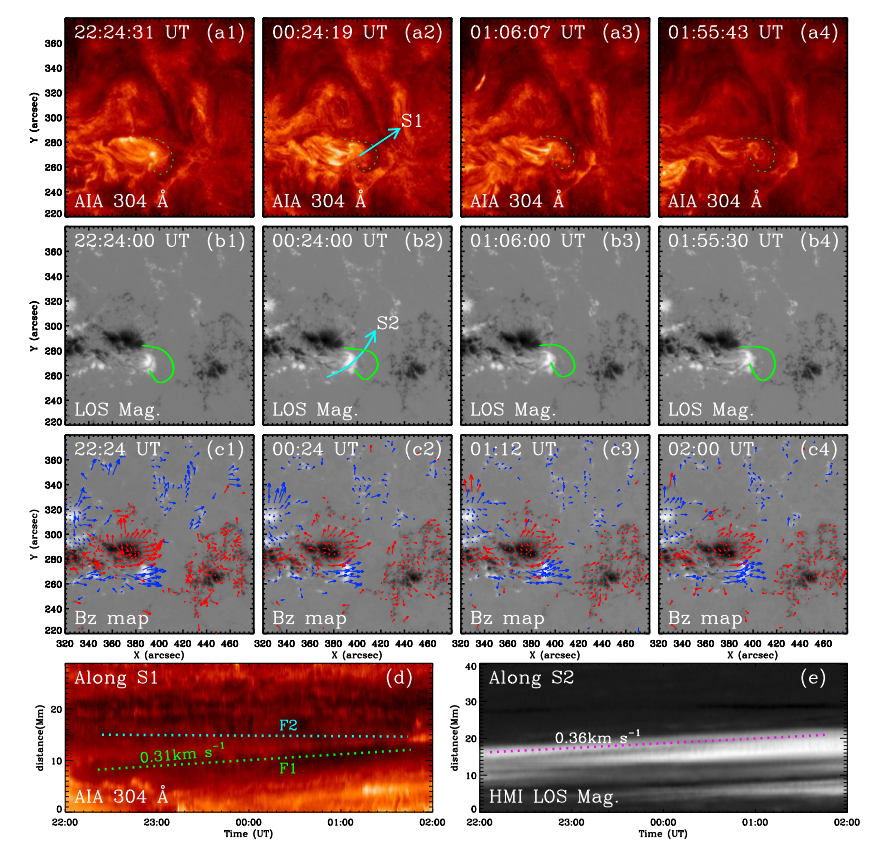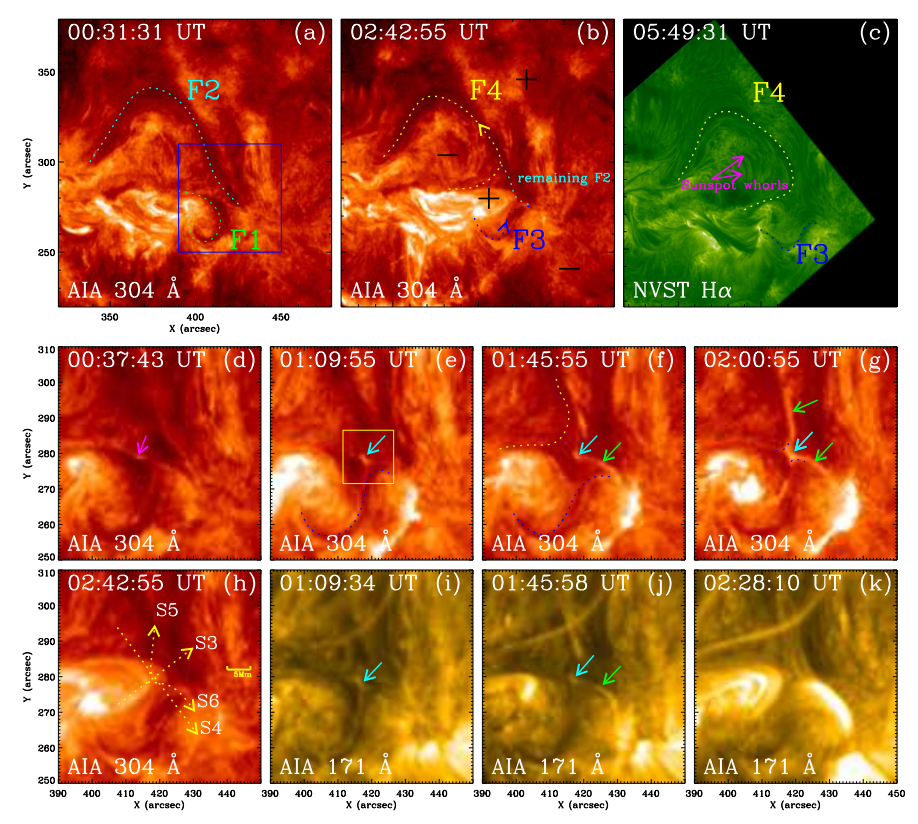Recently, graduate student WU Zongyin from the Fuxian Lake Solar Observatory of the Yunnan Observatories, Chinese Academy of Sciences, along with his supervisor, Researcher XUE Zhike, and collaborators, utilized joint observational data from four solar telescopes to capture the complete process of two solar filaments colliding and triggering magnetic reconnection. Their study revealed the full causal chain of the event: "photospheric driving → filament collision → magnetic reconnection → new filament formation." The work also uncovered how the evolution of the photospheric magnetic field drives filament motion and magnetic reconnection, as well as the influence of factors such as interaction angle, magnetic flux, and filament chirality on the reconnection process. The related research paper was recently published in The Astrophysical Journal.
Solar filaments are low-temperature, high-density plasma structures supported by magnetic fields in the solar atmosphere. Interactions between filaments can trigger magnetic reconnection and release magnetic energy. However, the detailed physical processes of magnetic reconnection triggered by filament collisions have lacked direct observational evidence. Additionally, most existing studies focus on filament interactions driven by eruptions, whereas how the slow motion of photospheric magnetic fields triggers reconnection through filament collisions has not been previously reported or investigated.
The researchers conducted a detailed study of two filaments (F1 and F2) in active region NOAA 13296 on May 9, 2023, focusing on their approach, collision, and observational evidence of magnetic reconnection triggered by the collision. The analysis was primarily based on high-resolution imaging data from the New Vacuum Solar Telescope, the Solar Dynamics Observatory/Atmospheric Imaging Assembly, and the Chinese Hα Solar Explorer, along with line-of-sight and vector magnetic field data from the Solar Dynamics Observatory/Helioseismic and Magnetic Imager.
By tracking the motion of the filaments and the photospheric magnetic field evolution near their footpoints and using time-distance diagrams and Differential Affine Velocity Estimator velocity field analysis, the researchers found that one filament remained nearly stationary, while the motion direction and speed of the other filament closely matched those of photospheric magnetic field at its footpoints. Notably, neither filament exhibited eruptive behavior during the process, demonstrating that photospheric magnetic field evolution alone can drive filament collisions and interactions. After reconnection, filaments F1 and F2 formed two new filaments (F3 and F4). Intriguingly, F1 completely disappeared, while F2 partially survived, a post-reconnection magnetic configuration termed "partial slingshot reconnection".
To explore the factors influencing reconnection and the formation of partial slingshot reconnection, the researchers analyzed the interaction angle, axial magnetic flux, and filament chirality. They estimated the interaction angle to be approximately 5π/4, consistent with the angular range (between π/2 and 3π/2) required for slingshot interactions. Both filaments were identified as sinistral in chirality, which, according to simulations by Linton et al., suggests they were weakly twisted—a possible explanation for their non-eruptive nature. F2, being larger and wider than F1, possessed greater axial magnetic flux, preventing complete reconnection and leaving a remnant suspended between the filaments. Building on prior studies, the researchers propose that since unequal magnetic flux between colliding filaments is more common in the corona, partial reconnection may occur more frequently than full reconnection.
This research was supported by the Pioneer Research Program of the Chinese Academy of Sciences (Category B), the National Science Fund for Distinguished Young Scholars, the Youth Innovation Promotion Association of the Chinese Academy of Sciences, and the Yunnan Key Laboratory of the Solar physics and Space Science.

Figure 1: the motion of filament F1 and the evolution of the photospheric magnetic field. Panels (d) and (e) display time-distance diagrams along slices S1 and S2, respectively. The green lines in panels (a1) to (b4) mark the positions of filament F1. The transverse magnetic field (panels c1-c4) is represented by blue (red) arrows superimposed on positive (negative) polarity regions of the longitudinal magnetic field. Image by WU.

Figure 2: the interaction process between filaments and the observational signatures of magnetic reconnection. In panel (b), the axial magnetic field directions of filaments F3 and F4 are represented by blue and yellow arrows, respectively. In panel (d), purple arrows indicate plasmoids, cyan arrows mark the current sheet, and green arrows denote outflows. Image by WU.
Contact:
WU Zongyin
Yunnan Observatories, CAS
E-mail: wuzongyin@ynao.ac.cn